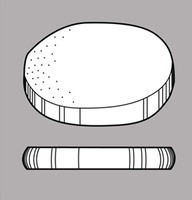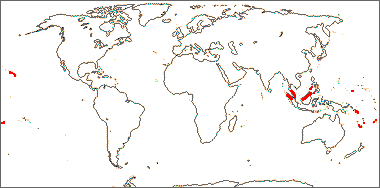Family name: Joinvilleaceae Tomlinson & A.C. Smith
Synonym(s): [none]
Common name(s): joinvillea Family
*Number of genera/species: 1/4
List of genera records in GRIN-Global
fruit
Fruit a drupedrupe:
(indehiscent drupe) a fleshy, indehiscent fruit with one more hard pits enclosing seeds, derived from single, superior, simple or compound ovary; (dehiscent drupe) a fruit with a dry or fibrous to fleshy or leathery outer husk that early to tardily breaks apart (or opens), exposing one or more nutlike pits enclosing the seeds with unilocular stone, sometimes plurilocular, stones without operculaoperculum:
with unilocular stone, sometimes plurilocular, stones without operculaoperculum:
a dehiscent cap (or lid) of a seed or fruit that opens during germination or dehiscence , 5 mm in diam., globoseglobose:
, 5 mm in diam., globoseglobose:
3D shape—more or less spherical to trigonoustrigonous:
to trigonoustrigonous:
3D shape—having three faces that meet at distinct angles; triangular in outline
, tereteterete:
approximately circular in cross section; width and thickness approximately equal
 or angledangular:
or angledangular:
2D shape—having sides that meet at acute or obtuse angles
in transection, with 1–3 seeds. Pericarppericarp:
fruit wall or fruit coat
often brightly colored, dulldull:
reflecting only a low proportion of incident light, with no apparent sheen , fleshy or chartaceouschartaceous:
, fleshy or chartaceouschartaceous:
papery, papyraceous
.
Seeds globoseglobose:
3D shape—more or less spherical or ovoidovoid:
or ovoidovoid:
3D shape—ovate , tereteterete:
, tereteterete:
approximately circular in cross section; width and thickness approximately equal
 in transection, minute. Seed coat membranousmembranous:
in transection, minute. Seed coat membranousmembranous:
texture—extremely thin, pliable, and fairly tough
, reticulatereticulate:
surface relief—netted, raised walls or concave grooves forming a net-like surface pattern with flat, concave, or convex interspaces .
.
Embryo minute, rudimentaryrudimentary:
(of embryo) embryo is small and fills less than a quarter of the seed and can be variable in shapes, such as linear, spatulate, or oval (without a cotyledoncotyledon:
(without a cotyledoncotyledon:
a primary leaf of the embryo ), discoiddiscoid:
), discoiddiscoid:
3D shape—resembling a disc
 , straight, caping one end of seed.
, straight, caping one end of seed.
Endosperm copious, mealymealy:
loose, dry, and disintegrating in finely granular
pieces like meal or flour
.
| Fruit | |
| Type | drupedrupe: (indehiscent drupe) a fleshy, indehiscent fruit with one more hard pits enclosing seeds, derived from single, superior, simple or compound ovary; (dehiscent drupe) a fruit with a dry or fibrous to fleshy or leathery outer husk that early to tardily breaks apart (or opens), exposing one or more nutlike pits enclosing the seeds  |
| Size range | 5 mm in diam. |
| Shape(s) | globoseglobose: 3D shape—more or less spherical  , trigonoustrigonous: , trigonoustrigonous:3D shape—having three faces that meet at distinct angles; triangular in outline , ovoidovoid: 3D shape—ovate  |
| Texture | fleshy, chartaceouschartaceous: papery, papyraceous |
| Color(s) | black, red, yellow, white, orange, brown |
| Unique features | Small often brightly colored drupesdrupe: (indehiscent drupe) a fleshy, indehiscent fruit with one more hard pits enclosing seeds, derived from single, superior, simple or compound ovary; (dehiscent drupe) a fruit with a dry or fibrous to fleshy or leathery outer husk that early to tardily breaks apart (or opens), exposing one or more nutlike pits enclosing the seeds  with minute seeds. with minute seeds. |
| Seed | |
| Size range | minute |
| Shape(s) | globoseglobose: 3D shape—more or less spherical  , ovoidovoid: , ovoidovoid:3D shape—ovate  |
| Surface relief | reticulatereticulate: surface relief—netted, raised walls or concave grooves forming a net-like surface pattern with flat, concave, or convex interspaces  |
| Unique features | Seeds globoseglobose: 3D shape—more or less spherical  or ovoidovoid: or ovoidovoid:3D shape—ovate  , tereteterete: , tereteterete:approximately circular in cross section; width and thickness approximately equal  in transection, minute. Seed coats membranousmembranous: in transection, minute. Seed coats membranousmembranous:texture—extremely thin, pliable, and fairly tough , reticulatereticulate: surface relief—netted, raised walls or concave grooves forming a net-like surface pattern with flat, concave, or convex interspaces  . . |
| Other | |
| Embryo | minute, rudimentaryrudimentary: (of embryo) embryo is small and fills less than a quarter of the seed and can be variable in shapes, such as linear, spatulate, or oval  (without a cotyledoncotyledon: (without a cotyledoncotyledon:a primary leaf of the embryo  ), discoiddiscoid: ), discoiddiscoid:3D shape—resembling a disc  , straight, caping one end of seed , straight, caping one end of seed |
| Nutritive tissue | endosperm copious, mealymealy: loose, dry, and disintegrating in finely granular pieces like meal or flour |
Malay Peninsula to the Pacific.

Distribution map courtesy of Angiosperm Phylogeny Website.
Baskin and Baskin 2021Baskin and Baskin 2021:
Baskin C and Baskin J. 2021. Relationship of the lateral embryo (in grasses) to other monocot embryos: A status up-grade. Seed Science Research 31 (3): 199-210. doi:10.1017/S0960258521000209; Dahlgren et al. 1985Dahlgren et al. 1985:
Dahlgren RMT, Clifford HT, and Yeo PF. 1985. The families of the monocotyledons: structure, evolution, and taxonomy. Springer-Verlag, Berlin. 520 pp.; Nooteboom et al. 2021+Nooteboom et al. 2021+:
Nooteboom HP, de Wilde WJJO, Stevens PF, Coode MJE, and Saw LG. 2021+ Flora Malesiana Online. Accessed January 2021–March 2024. URL: https://portal.cybertaxonomy.org/flora-malesiana/; Kirkbride et al. 2006Kirkbride et al. 2006:
Kirkbride JH, Jr, Gunn CR, and Dallwitz MJ. 2006. Family guide for fruits and seeds, vers. 1.0. Accessed September 2020-January 2022. URL: https://nt.ars-grin.gov/seedsfruits/keys/frsdfam/index.cfm .; Kubitzki et al. 1990+Kubitzki et al. 1990+:
Kubitzki K et al., eds. 1990+. The families and genera of vascular plants. 7+ vols. Berlin etc.; Stevenson and Loconte 1995Stevenson and Loconte 1995:
Stevenson DW and Loconte H. 1995. A cladistic analysis of monocot families. In: Rudall PJ, Cribb PJ, Cutler DF, and Humphries CJ, eds. Monocotyledons: Systematics and Evolution. Royal Botanic Gardens, Kew.
*The number of genera and species is based on Christenhusz and Byng 2016Christenhusz and Byng 2016:
Christenhusz MJM and Byng JW. 2016. The number of known plant species in the world and its annual increase. Phytotaxa 261 (3): 201-217. https://doi.org/10.11646/phytotaxa.261.3.1, which may differ from the number of genera in GRIN-Global.